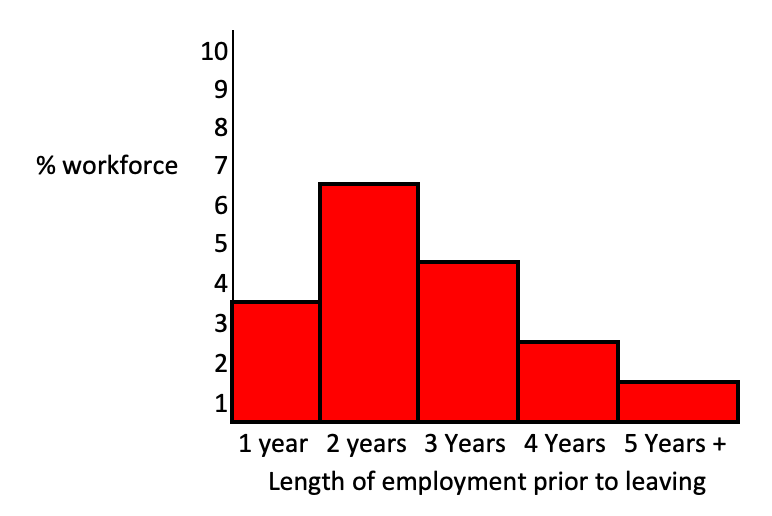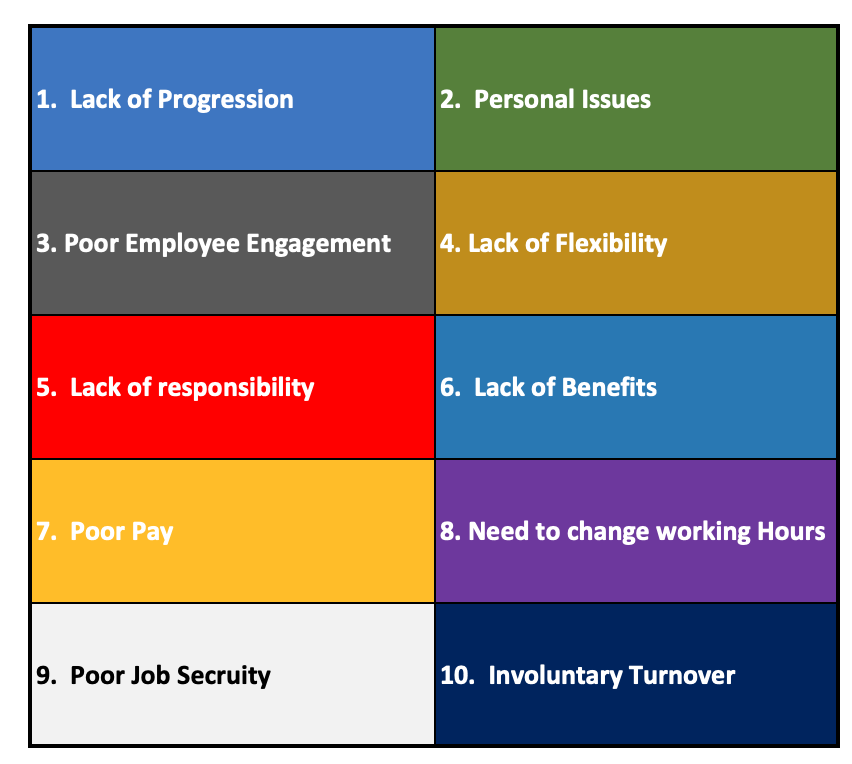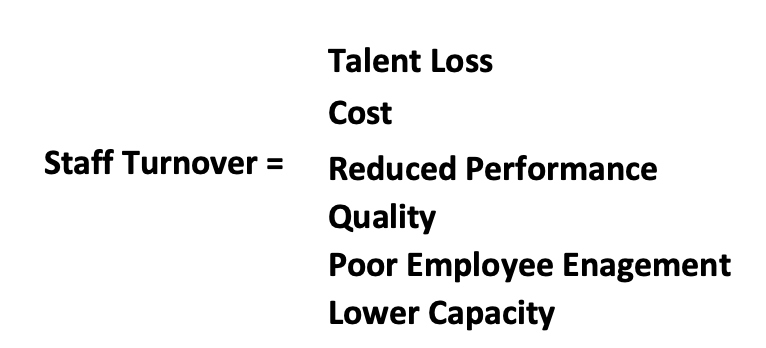
The impact of a low retention rate can be significant to a business, with multiple reasons behind the numbers. Surprisingly many organizations suffer its consequences without either understanding or analyzing it.
While there can be subtleties between industries and the organizations within them, some common themes warrant investigation especially when you consider what employees leaving a company can do to it.
In today’s article, we’ll be exploring those themes and looking at ten reasons for low retention rates. This should provide some insight into drivers behind the numbers in your own organization, we’ll also investigate what you can do if you have a low figure.
In today’s piece, we’ll be covering
- What is a retention rate
- What do we mean by a low retention rate
- Ten reasons for a low retention rate
- Why does a low retention rate matter
- What to do if you have a low retention rate
What is a retention rate?

Let’s start with the basics:
An organization’s employee retention rate applies to an organization’s capability to retain or keep its employees.
People leaving their job is not a new phenomenon, and it is not an isolated incident.
People leave their jobs.
The US bureaux of labor statistics show that, on average, over 3 million people leave their jobs per month.
The employement market is competative, the top talent are in demand and you need to know your numbers.
Retention rate is commonly calculated as follows:
Number of employees leaving in the period divided by the average number of employees in period X 100
You can also calculate it by assessing how long employees have been with the organization (i.e., % of employees who have been with the company for 1, 2,3, 4, 5+ years, for example) (see below graph as an example)

What do we mean by a low retention rate?
Firstly it’s important to understand that retention rates will vary by various factors such as industry, company, geographical region.
For some, a retention rate less than 90% is a problem; for others, it’ll be more, and for others, it’ll be less.
What’s important is assessing:
- How do the figures compare to your national average?
- How do the figures compare to your industry?
- How do the figures compare to your targets?
- What is the impact of the figures on your business?
- Was it preventable?
Ten reasons for low retention rate:
Let’s now consider some of the reasons why people leave their jobs:

1/ Lack of Progression
The number one reason people leave an organization is a lack of career progression.
After a period of time in a role, if advancement looks unlikely, people will probably start exploring opportunities outside the organization.
Statistics show that many employees would stay at a company if it invested in a long term career progression for them.
2/ Personal Issues
Often overlooked, a significant reason that people leaving an organization are personal issues that affect their employment.
Issues such as childcare, caring for a sick relative, relocation can all drive change.
3/ Poor employee engagement
Forbes quotes that an effective employee engagement program can reduce turnover rates by 59%, providing both “clear expectations” and “tools and support to do their best work.”
4/ Lack of flexibility
Flexible working practices, arrangements that consider an individual’s personal needs, can benefit both employer and employees. Where this is lacking but can be obtained elsewhere, it can represent a key driver for people changing employers.
5/ Lack of responsibility
People like to have a meaningful role, for many responsibilities that come with their role provide that. Responsibility can be a key component of job satisfaction. If it’s not present, it can drive the role to be boring and mundane. Where this can’t be resolved internally, then all too often, the employee will look to find it elsewhere.
6/ Lack of benefits
Let’s put the point about pay to one side for a moment (we’ll cover that soon enough). A lack of benefits can be reason for an employee to leave. Benefits can include:
- Holidays
- Sick Pay
- Training / Development
- Healthcare
- Free meals or canteen vouchers
- etc
Where another company offers better benefits for the same role – this can drive a change.
7/ Pay / Renumeration
While this may be the first reason you think of when considering why people leave thier jobs (it’s not see note1), it still has significance and is often one of the first things people who are considering leaving an organization compare. Higher salaries elsewhere can present a big pull to change companies. The longer an employee stays with an organization while seeing pay differential, the greater this pull is likely to be.
8/ Change in working hours
This can be one of two ways, either a change to a full-time role (from part-time hours) or a move to a part-time role from full-time hours.
Often driven by personal circumstances, where the parent company is unable to meet the employee’s needs, then this can be a clear reason to change organizations.
9/ Poor job security
It is never pleasant when a company is struggling, or roles are under pressure from changes in the organization.
Where employees are faced with concerns over losing their jobs (or having to reduce hours), a switch of organizations may be necessitated.
10/ Involuntary turnover
Our final example reminds us that retention rates are not always driven by the employee’s desire to leave. Retention rates are also affected by people leaving organizations at the request of their employers – this may be due to things like:
- Poor performance
- Insubordination
- Layoff/redundancy
- Retirement
Why does a low retention rate matter

So now we’ve covered some examples, let’s now look at why retention rates are important.
There are several reasons for this, which include:
- Talent loss – if you’re losing people, you lose talent; when people depart a company, they take their knowledge and experience with them. Everyone leaving will have an impact, but this is especially true where you lose subject matter experts.
- Cost – When people leave, there are several areas of cost that can impact the business. This includes:
- Recruitment costs – The cost of finding and hiring someone to replace the individual that has left
- Performance costs – The performance hit that the organization will suffer as a result of the person leaving.
- Performance – Performance is normally always impacted by employees leaving, the loss of knowledge, the time taken to replace an individual can all combine to impact performance.
- Quality – Where experienced individuals leave an organization, there is the risk that there will be a corresponding impact on quality.
- Employee engagement – It’s not surprising that employee engagement takes a hit with people leaving an organization. The team members that are left often feel the impact of knowledge loss or see for themselves the issues that led to the individuals leaving, which all lead to an impact on morale.
What to do if you have a low retention rate

Even though people leave their jobs, for many, this can be avoided, Workinstitute.com speculated in this recent report that “3 out of 4 employees who quit could have been retained.”
So what can you do if you perceive that you have a low retention rate?
Firstly you need to assess where you actually are and measure it.
A recent study (https://www.imercer.com/articleinsights/north-american-employee-turnover-trends-and-effects) showed that on average, only 63% of orgniaziaonts tracked their retention rate and peoples reasons for leaving.
You’ll want to know your numbers ( to calculate your rate) and the reasons (or some assumptions) on the why. Gathering accurate data is notoriously challenging, exit interviews can provide innacurate results and you’ll need to assess the best methods of gathering meaningful facts to support your data.
Secondly, you’re unlikely to solve everything; look to analyze the main drivers behind people leaving your company and put steps in place to fix those things first.
Thirdly, develop mitigation strategies that cater to the reasons driving the highest numbers. If employee engagement is what’s driving people to look elsewhere, look to develop your engagement program. If it’s pay and benefits, look at how these can be reviewed.
Once again you may not be able to focus on the whole organizaiton and you might want to develop strategies that focus on retaining your top talent.
Summary
Although employee retention can be daunting and people leaving can cause headaches, remember that measuring retention rates can teach you a lot about your organization.
This can include aspects about your employees and what’s happening in the industry. It also forces you to review your strategy for retaining your talent.
A final point to consider is that you’ll never stop everyone; there will always be certain reasons for employees leaving that will beyond your control. It’s the areas that you can influence that should be your focus.
This article is part of our Human Resources Guide.